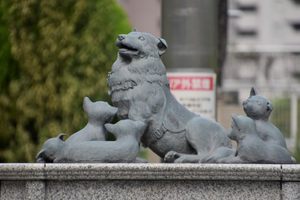About
Namiyoke Inari Shrine stands on the water’s edge close to the Tsukiji Fish Market, in the Chūō district of Tokyo. The shrine and market sit upon land reclaimed from the sea after much of the city was destroyed during the Great Fire of Meireki in 1657.
Locals attempted to rebuild after the fire, but the river’s destructive waves hindered their efforts. The struggle had continued for two years when, according to legend, a glowing sacred object was seen floating on the water's surface. A shrine was built to house the item, in which Inari is said to reside, and the waves finally calmed. The shrine was named Namiyoke (波除), or"protection from waves," in honor of this origin.
Taking pride of place at the entrance of this sacred space, immediately after the shrine's torii gate, are two tremendous shishi lion heads. These lions honor the shrine's legendary origin, for Japanese legend has it that a lion's roar is able to overcome the powers of tigers and dragons, animals who are thought to rule over the wind and clouds, and as such, waves. As part of the shrine's vibrant Tsukiji Shishi Matsuri Festival, the shrine’s two giant lion heads are paraded throughout the area's high-spirited streets.
Weighing one tonne, the larger lion head is an imposing presence even when resting within the shrine. Known as the Tenjō Ōjishi (天井大獅子 - Great Heavenly Shishi), this one-tonne titan bears a richly detailed brow and golden grin of sharp teeth. While lighter, at 700kg, the vibrant vermillion lion, Benzaiten Ohaguro Shishi (弁財天お歯黒獅子 - Benzaiten Black-Toothed Shishi), is a striking sight in its own right, and during the festival is borne by an all-female entourage in honor of its association with the goddess Benzaiten.
Related Tags
Know Before You Go
Visitors are asked to be respectful when visiting the shrine, which is an active place of worship.
Hidden Japan: Sado Island, Nara & Kyoto
Explore a different side of Japan.
Book NowPublished
October 1, 2024































